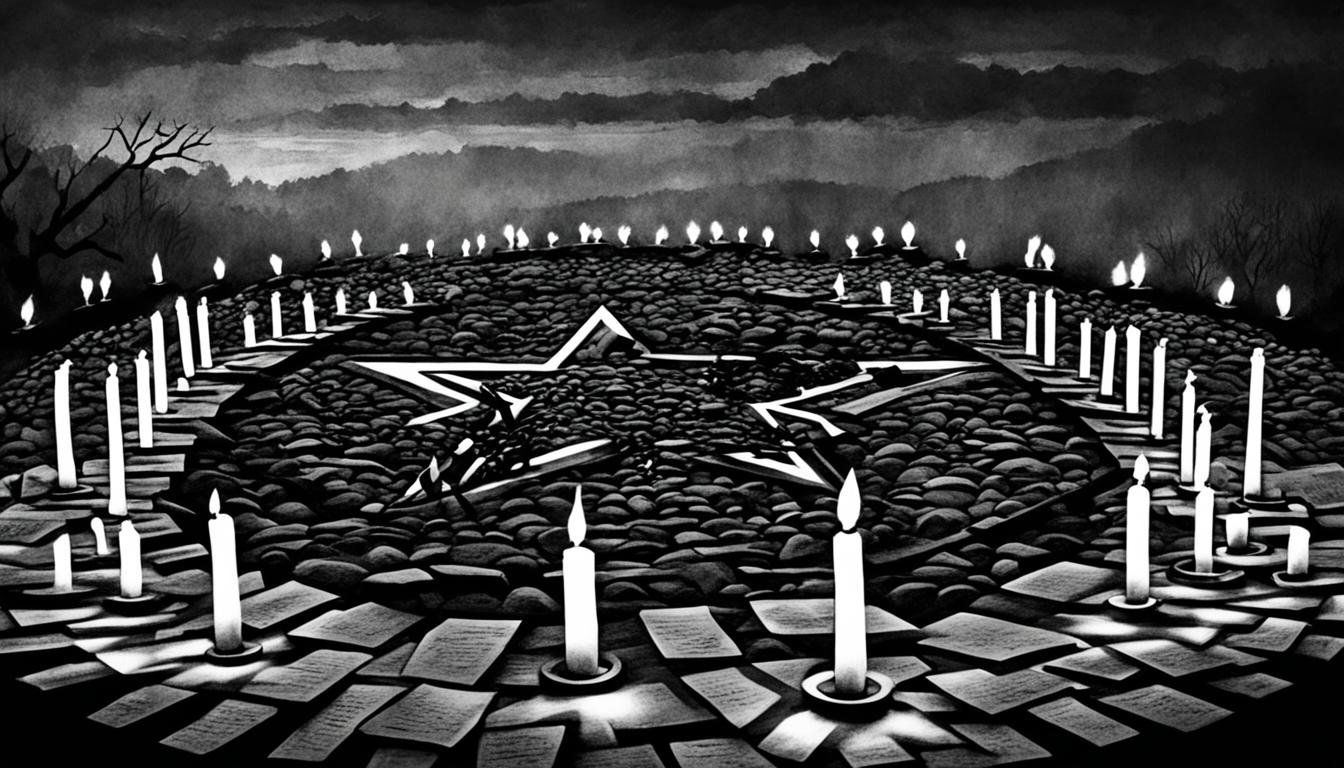Thirty years ago, Steven Spielberg’s Schindler’s List hit theaters. It quickly became the key English movie on the Holocaust. The movie, based on Thomas Keneally’s “Schindler’s Ark”, follows Oskar Schindler. He was a German businessman who saved more than 1,000 Jews during World War II. This film didn’t just show the world the horrors of the genocide. It also changed the way we remember and learn about the Holocaust.
- Schindler’s List, a 195-minute black-and-white film, made over $300 million at the box office.
- The movie earned seven Academy Awards, including Best Picture and Best Director.
- When Ford Motor Company aired the film on NBC in 1997, 65 million people watched it. This made the total viewers about 200 million by then.
- More than 10,000 people were at the United States Holocaust Memorial Museum’s opening in 1993.
- Even without big stars, Schindler’s List was very successful in making money and engaging the audience.
Key Takeaways:
- Directed by Steven Spielberg, Schindler’s List had a huge influence. It made over $300 million at the box office.
- The movie scored seven Academy Awards, including Best Picture and Best Director, making it a cinematic classic.
- Ford Motor Company’s broadcast on NBC drew 65 million people to watch, helping many more see the film.
- It was released around the founding of the United States Holocaust Memorial Museum. This highlighted the importance of remembering the Holocaust.
- Even without big stars, Schindler’s List made a global impact. It showed the world the strength of a heartfelt story.
The Inspiration behind Schindler’s List
Schindler’s List, directed by Steven Spielberg, is based on the novel “Schindler’s Ark” by Thomas Keneally. It’s about Oskar Schindler, a German who saved over 1,000 Jewish lives during the Holocaust.
The book was inspired by Leopold Page, who was saved by Oskar Schindler. Keneally was fascinated by his story and decided to explore Schindler’s life further. This led to the creation of his novel.
Keneally’s book is more than just a story. It honors the Jewish people and their strength during the Holocaust.
The Complexity of Oskar Schindler
In “Schindler’s Ark,” Oskar Schindler is shown as a man who changes over time. At first, he helps Jews for money but later does it for selfless reasons.
“Whoever saves one life, saves the world entire.” – Oskar Schindler
This quote shows how saving lives is important. It reflects Schindler’s journey from greed to selflessness.
“Schindler’s List” stands as a classic story of bravery and hope. It tells of one man’s incredible act. And about the strength and kindness in us all.
| Key Facts: | Associated Keywords: |
|---|---|
| – The movie Schindler’s List was released in theaters on December 15, 1993, with a limited re-release 25 years later in 2018. | Schindler’s List, Oskar Schindler, Holocaust, World War II |
| – The film won two Academy Awards for Best Directing and Best Picture. | Schindler’s List, Academy Awards |
| – The real Oskar Schindler started showing care for his Jewish laborers by constructing a sub-camp on the factory premises in 1943. | Oskar Schindler, sub-camp, factory premises |
| – Marcel Goldberg made two lists of people approved to go to Brünnlitz from Plaszów, one with 300 women and another with 700 men, known as “Schindler’s lists.”. | Marcel Goldberg, Brünnlitz, Plaszów, Schindler’s lists |
The Making of Schindler’s List
Steven Spielberg faced doubts when he decided to direct Schindler’s List. There were questions if he could handle it. But, the growing doubts about the Holocaust’s reality spurred him to turn this story into a movie.
The choice to shoot it in black and white was key. It made the film feel real and captured the grimness of that time. Spielberg’s keen eye for detail and hard work are seen in every scene.
Though he had to deal with time and money being tight, Spielberg moved ahead with unflinching zeal. He even managed both Schindler’s List and Jurassic Park together. This shows how deeply he was invested in this story.
Spielberg opted not to take his usual fee for the film, calling it “blood money.” Instead, he donated all earnings to the foundation he created. This gesture underlines his real aim to honor Holocaust survivors.
Ralph Fiennes put on 28 pounds to play Amon Goeth, showing his dedication. He brought a dark allure to the villain’s role. His portrayal plays a crucial part in the film’s success.
The choice to present the ‘Girl in the Red Coat’ in color was on purpose. In a movie in black and white, she stands out in color. This decision highlights the individuality of each victim and hits home their suffering.
Oliwia Dabrowska, who played the ‘Girl in the Red Coat,’ watched the movie before she planned to. She saw it at 11, feeling the heavy impact of the story. This shows how deeply the film affected even those in it.
John Williams wasn’t sure he could compose a fitting score for the movie. But, in the end, he created a moving soundtrack that won an Oscar. His music is now a key part of the film’s soul.
The making of Schindler’s List was not easy, but everyone’s hard work showed. Spielberg’s grit, along with the efforts of the cast and crew, resulted in a timeless movie. It tells a crucial historical account, keeping the memory of that time alive.
| Director | Steven Spielberg |
|---|---|
| Lead Actor | Liam Neeson |
| Genre | Historical Drama |
| Release Year | 1993 |
The Impact of Schindler’s List on Holocaust Education
When Schindler’s List premiered in 1993, it made a huge splash. Its impact was felt worldwide. The timing was especially important. It came out with the opening of the U.S. Holocaust Memorial Museum. This brought new focus to the Holocaust, opening up vital discussions about fighting hatred and intolerance.
After the film’s success, director Steven Spielberg started the USC Shoah Foundation in 1994. This foundation’s goal is clear: to keep the stories of Holocaust survivors alive. There are now tens of thousands of testimonies in various languages. It doesn’t just cover the Holocaust. There are also stories from other dark periods, like the Armenian genocide and violence against the Rohingya, and records on modern antisemitism.
Schindler’s List pushed for more Holocaust education in schools too. Several states made it a must to teach about genocide. Some require these lessons, like in California and Illinois. And there are new laws proposed in places like Florida and New Jersey. These bills aim to stress the value of learning to fight prejudice and hatred.
Studies show why this type of education is crucial. For example, a poll discovered that 20% of high schoolers and 22% of adults thought the Holocaust might not be real. But, a follow-up survey found these numbers dropped dramatically with clearer questions. This proves that in-depth Holocaust education is essential to prevent false beliefs and keep history vivid.
Many worked hard to make Schindler’s List a school teaching aid. People like U.S. Senator Arlen Specter and U.S. Secretary of Education Richard W. Riley pushed for it. With a movie and study guide, distributed to every American high school, millions of students got to watch and discuss it.
In the end, Schindler’s List not only impacted film watchers but played a key role in shaping legislation and school initiatives. It ensures the Holocaust’s memory is kept alive through proper education. The film continues to influence how we learn and remember the Holocaust, making our society more aware and caring.
Schindler’s List and Jewish Identity
There are key moments in life that really change us. For Steven Spielberg, making Schindler’s List was one of those moments. This famous movie deeply connected with his Jewish family history.
Spielberg was already famous in Hollywood. But, Schindler’s List was special. It touched on Spielberg’s family background. The film’s focus on the Holocaust and how it affected the Jewish people deeply moved him.
Although Schindler’s List is not about Spielberg’s life, it reflects his family’s loss in the Holocaust. The movie was his way of honoring them. It also aimed to show the world the suffering and courage of the Jewish people during the Holocaust.
Through Oskar Schindler’s story, Spielberg honored his heritage. He portrayed Schindler as a hero who saved many Jewish lives. This connected Spielberg to his Jewish roots.
By featuring Oskar Schindler, Spielberg showed the Holocaust’s horrors. He also encouraged other Jewish filmmakers to tell their stories. His aim was to highlight Jewish history’s resilience and the importance of keeping its memories alive.
Making Schindler’s List made Spielberg proud of his Jewish identity. It motivated him to spotlight issues like justice and fighting evil. His later films carry these moral themes, making him a significant voice against injustice.
“Schindler’s List was a turning point for me. It made me proud to be Jewish and inspired me to use my platform to shed light on important historical events and the struggle for justice.”
Schindler’s List not only mattered to Spielberg. The movie’s impact on Jewish identity and the memory of the Holocaust is global. It reminds us all of the need to cherish and learn from our shared past.
Next, we’ll look at Schindler’s List influence on the movie world. It was a big hit and touched many hearts with its story.
Schindler’s List as a Cultural Milestone
When Schindler’s List came out thirty years ago, it was not just any movie. It quickly became a classic and made a huge impact in the film world. Even though it was nearly three hours long and mostly in black-and-white, people all over the world loved it. The movie made more than $300 million and won seven Oscars, including the Best Picture and Director awards.
Director Steven Spielberg’s work exposed the terrible truth of the Holocaust and World War II. His movie was a vivid reminder of the suffering that millions went through. Schindler’s List showed everyone that a story about the Holocaust could be both moving and successful.
“Schindler’s List emerged as a watershed moment in the film industry, challenging the notion that historical dramas could not captivate audiences and generate significant box office returns.”
– Robert Giroux / AFP via Getty Images
The impact of Schindler’s List went far beyond the big screen. In 1993, over 10,000 people came together in the U.S. to see the Holocaust Memorial Museum’s torch start burning. This was thanks to the movie raising awareness about the Holocaust. Later, in 1997, Ford sponsored a commercial-free airing of the film on NBC, which 65 million people watched. By then, about 200 million people worldwide had seen it.
Nielsen said that on the night the movie aired, more than a third of all U.S. TV sets were showing Schindler’s List. This large audience showed the movie’s ability to draw in people and start important conversations about World War II and the Holocaust.
Schindler’s List greatly impacted how we remember and learn about the Holocaust. In the movie’s wake, Steven Spielberg started a foundation that records and shares the stories of tens of thousands of survivors. This helps ensure their stories will never be forgotten.
Through the film’s 3 hours and 15 minutes, viewers got a detailed and moving look at life in the Krakow ghetto during the Holocaust. The choice to film primarily in black and white made every moment feel more important and touching.
Ralph Fiennes’s role as Amon Göeth, a chilling SS officer, was very powerful. His performance highlighte”d the horrifying experiences of Jewish people during the Holocaust. It deepened the film’s emotional impact.
The movie also included scenes like the ghetto’s liquidation and a girl in a red coat. These moments were powerful symbols of the Holocaust’s horrors and the need to remember them.
Steven Spielberg’s direction in Schindler’s List really stands out. He expertly wove together deep emotions with historical facts. His skill made the movie unforgettable and changed how the film world sees historical dramas.
| Statistics | |
|---|---|
| Total Box Office Earnings | $300 million |
| Academy Awards Won | 7 |
| Viewership of Ad-Free Broadcast | 65 million |
| Households Tuned in to Schindler’s List | More than one third |
| Number of Holocaust survivors’ testimonies recorded by USC Shoah Foundation | Tens of thousands |
More than just a successful film, Schindler’s List showed the worth of telling Holocaust stories onscreen. It started a global push for remembering and learning from the Holocaust. Thanks to the movie, we are reminded never to forget the awful things that happened.
Schindler’s List as a Tool for Holocaust Remembrance
Schindler’s List is a moving movie directed by Steven Spielberg. It has become known as a key way to remember and learn about the Holocaust. Its release in 1993 matched the opening of the United States Holocaust Memorial Museum. This created a new focus on understanding and remembering the Holocaust.
The movie’s impact was felt long after its debut. It made over $300 million and won seven Academy Awards. By 1997, around 200 million people had seen it. The world saw the horrors of the Holocaust in a new light because of this film.
After the film, Spielberg founded the USC Shoah Foundation in 1994. This foundation gathers and shares stories of survivors, not just from the Holocaust but from other tragedies too. These stories are a key way to teach and learn about the Holocaust, ensuring we remember this dark time in history.
The film also inspired educational efforts. For example, schools were offered free showings. Study materials were given out to help students understand the Holocaust better. The aim was to teach young people about the Holocaust and the importance of being kind and open-minded.
Yad Vashem and the Fight Against Antisemitism
As antisemitism grows, places like Yad Vashem are more important than ever. It’s Israel’s memorial for the Holocaust’s victims. Yad Vashem honors non-Jews who saved Jews during the Holocaust. You can find their stories on their website, showing the brave and kind acts of these heroes.
Lately, Yad Vashem has made its website better. This helps more people learn about the Holocaust. They also train teachers to share this history in caring ways. The goal is to make sure we never forget the lessons of the Holocaust and to fight against hate today.
| STATISTICS | FACT |
|---|---|
| Schindler’s List box office earnings | Over $300 million |
| Number of Academy Awards won by Schindler’s List | Seven, including Best Picture and Best Director |
| Number of people who watched Schindler’s List by 1997 | Roughly 200 million |
| Number of testimonies recorded by the USC Shoah Foundation | Tens of thousands |
| Number of Jewish children murdered by the Nazis during the Holocaust | One-and-a-half million |
The Real Story Behind Schindler’s List
Schindler’s List, a film by Steven Spielberg, tells elements of a true story. There are differences between the movie and what really happened, though. The film shows Oskar Schindler, a German man who saved over 1,000 Jews during the Holocaust, as the hero.
The movie and real life don’t exactly match when it comes to creating the famous list. It shows Schindler making the list in jail. But, it was actually Abraham Bankier, his Jewish Polish co-owner, who convinced Schindler to save Jewish people’s lives.
Even with these differences, Schindler’s List shows Schindler’s amazing efforts. It shines a light on the terrible living conditions in the Krakow Ghetto and Plaszow camp. The movie is a strong reminder of the terrible things that happened during the Holocaust.
About one third of the people on Schindler’s lists had worked for him before. This shows how big of an impact he had. By saving these lives, he did something remarkable.
The movie also shows a part where people were inspected before being moved to Brünnlitz. Men were sent to Gross-Rosen camp, and women to Auschwitz. Even though exactly how it was done isn’t shown, details from survivors like Rena Finder are very clear. They describe a painful process with head-shaving and cold showers, showing the cruelty these people faced.
True, the film and reality differ somewhat. But Schindler’s List is still an important movie. It highlights Oskar Schindler’s bravery. And it tells us about the terrible truth of the Holocaust.
Schindler’s List: A Realistic Depiction of the Holocaust
Schindler’s List was released on December 15, 1993, in theaters. It’s an exceptional film that shows the harsh reality of the Holocaust. This movie vividly captures the suffering faced by those targeted by the Nazis.
Steven Spielberg directed this film, telling the true story of Oskar Schindler. He was a German who saved more than a thousand Jewish people. The film’s attention to detail makes the horrors of the Holocaust come alive, touching viewers deeply.
It focuses on the challenges and pains the Jewish community faced daily during World War II. The film’s realism helps audiences understand the vast suffering experienced by many innocent people.
Though some parts were made up to tell a story, overall, the film feels very real. It shows both the worst of humanity and the best. Schindler’s List makes us think about the past injustices and encourages us to fight against future wrongs.
After Schindler’s List, Hollywood and the world paid more attention to the Holocaust. This movie sparked more interest in learning about this dark period. It led to the creation of the USC Shoah Foundation, which collects stories of Holocaust survivors.
The Realism of Schindler’s List
This film doesn’t exaggerate the Holocaust. It tries to show exactly what happened during that time with great attention to detail. Even the decision to film in black and white adds to this authenticity.
The movie portrays the terror and sufferings of the Jewish people under Nazi rule. It’s a heartbreaking look at the cruelty humanity is capable of.
Resonating Impact
Schindler’s List still moves audiences deeply, even 25 years after its debut. Its lasting impression shows its power in reminding us of the Holocaust’s reality. It motivates us to fight against injustice.
As we remember this significant film, it’s important to recall its lessons. Schindler’s List ensures the victims’ voices are heard and their stories are remembered. It teaches future generations the importance of never forgetting these horrific events.
| Year | Awards |
|---|---|
| 1994 | Academy Awards for Best Directing and Best Picture |
In 1993, Schindler’s List premiered, changing the way we see the Holocaust. It made people worldwide aware of the brutalities of that time. The film’s impact on education and remembrance is huge. Its honest portrayal reminds us to never forget the Holocaust and the strength of the human spirit.
Conclusion
Steven Spielberg’s Schindler’s List is a key film on the Holocaust. It tells Oskar Schindler’s story and highlights the tragic events vividly. The film’s impact on teaching about the Holocaust, remembering its victims, and the movie world is huge. It shows the terrible crimes of the Holocaust, making sure we never forget Schindler’s and others’ bravery.
Schindler’s List picks a few uplifting stories, turning the Holocaust into a tragic yet hopeful tale. But we must remember that many survivors faced hard times, not happy endings. It points out how extreme nationalism harms society and turns people into killers. This shows the strong influence that governments can have on their citizens.
The movie makes us think about human life’s importance and our values. When Schindler understands he could’ve saved more but didn’t act sooner, it stirs strong feelings. This makes us wonder about our own choices when facing evil.
Schindler’s List also focuses on the fate of those in the Kraków Ghetto and Schindler’s workers. It movingly captures the survivors’ thankfulness towards Schindler. They offer a letter and a ring as a sign of their eternal gratitude, saying, “Whoever saves one life saves the world entire.”
FAQ
What is the impact of Schindler’s List on history?
Schindler’s List, directed by Steven Spielberg, is a key English-language movie on the Holocaust. It deeply influenced how people think and feel about the Holocaust. This made a big impact on how we remember and teach about it today.
What inspired the creation of Schindler’s List?
Schindler’s List was inspired by the true story of Oskar Schindler. It is based on the novel “Schindler’s Ark” by Thomas Keneally. The novel tells of Schindler’s actions to save Jews during World War II.
How was Schindler’s List made?
Steven Spielberg faced some doubts at first but took on the challenge. He chose to film in Poland to capture the real places and feelings. The movie was shot in black and white to show the historical time. Spielberg juggled working on Schindler’s List and Jurassic Park, showing his commitment.
What impact did Schindler’s List have on Holocaust education?
It brought the story of the Holocaust to many people. This sparked new interest in learning about the Holocaust and fighting hatred. The movie also led to special showings for students and sharing educational materials.
How did Schindler’s List affect Steven Spielberg’s Jewish identity?
Spielberg’s work on Schindler’s List made him feel proud of his Jewish heritage. It inspired him and other Jewish filmmakers to tell more stories about their culture.
Why is Schindler’s List considered a cultural milestone?
Despite its long length and not having famous stars, Schindler’s List was beloved by people around the world. It earned more than 0 million and won seven Oscars. These included awards for Best Picture and Best Director.
How is Schindler’s List used as a tool for Holocaust remembrance?
The film inspired the USC Shoah Foundation. This organization records stories of Holocaust survivors. Schindler’s List continues to be a powerful way to remember the Holocaust.
Are there discrepancies between Schindler’s List and the actual events?
Some parts of the film are changed for storytelling, like Schindler’s list creation. But, the film still shows the horrors of the Holocaust accurately. For instance, Abraham Bankier’s story as a Jewish former factory owner in Poland isn’t in the film.
Is Schindler’s List a realistic depiction of the Holocaust?
Schindler’s List is widely seen as a true and moving depiction of the Holocaust. Though not every detail is exact, it does well to show the Nazis’ brutality and the struggles of the victims.
What is the significance of Schindler’s List as a historical drama?
Schindler’s List stands as a key film about the Holocaust. It puts the Holocaust at the front of people’s minds. This ensures the stories of Oskar Schindler and the Holocaust are remembered.








